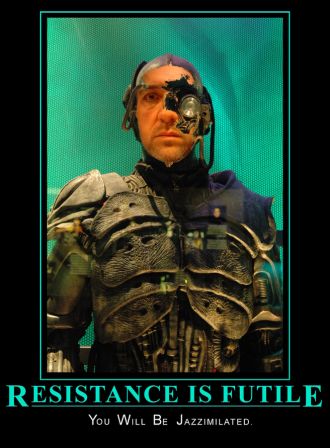 This article comes from a Guitar Live challenge on my composition « Printemptation » from the album @-quartet. It was an improvisation challenge that some people found difficult (to be honest, it was !). In this article, I'm transcribing some advice I gave on the occasion as well as my personal view on the way to approach delicate scores and on the fundamental ingredients that make an improvisation worth listening to. This is mostly about the semantic aspects of improvisation (Cf. the article The (natural) Language of Improvisation). You can click on the icon on the right to download the score of this tune. You can also download the tune itself from tyhe album's page.
This article comes from a Guitar Live challenge on my composition « Printemptation » from the album @-quartet. It was an improvisation challenge that some people found difficult (to be honest, it was !). In this article, I'm transcribing some advice I gave on the occasion as well as my personal view on the way to approach delicate scores and on the fundamental ingredients that make an improvisation worth listening to. This is mostly about the semantic aspects of improvisation (Cf. the article The (natural) Language of Improvisation). You can click on the icon on the right to download the score of this tune. You can also download the tune itself from tyhe album's page.
General presentation
Printemptation is an interesting composition from the perspective of improvisation because, although based on very common harmonic figures in Jazz (as a matter of fact, in the whole occidental music), it comes with two major difficulties.
By reading the score, you will notice that this tune is almost exclusively built on top of II V I's, either major or minor. II V I is indeed the most frequent harmonic progression in Jazz, and is actually the unavoidable grounding for all occidental music (the well know principle of tension/resolution). To play with this figure is probably the first thing that you learn when you begin improvisation. So, if the Occident is so familiar with II V I's, where are the difficulties ?
The first one is that this tune moves a lot. If you sequentially "unfold" it, let alone the "reprise" (what's the word in English?), you can count no less than eleven different keys. The second one is that the rhythmic figure changes at two different places, introducing 3/4 bars.
Approaching the harmony
As far as the harmonic progression is concerned, and given that improvising on II V I's is not very challenging, it is more important here to master the key changes than the different keys themselves. By the way, this is one of my musical creeds: what makes the quality of an improvisation is not so much the phrases than how they are articulated together. A sequence of "correct" but unrelated phrases is uninteresting. On the other hand, a logical link that makes your phrases relate to each other turns your improvisation into a true musical story, with an opening, a "middle" and an ending. That's where musicality is found.
You will also notice that the tune's theme is representative of this idea by itself: the pattern expressed in the first 3 bars is almost constantly repeated, only under different shapes (different harmonic contexts), that contribute to unify all the encountered keys, by giving them a common logic...
Approaching the rhythm
As far as the rhythmic subtleties are concerned: in occidental music, we are more accustomed to key changes than rhythmic ones. One should then pay attention not to be destabilized by the incursion of the 3/4 bars. Besides, the improvisation must be sufficiently in "harmony" with the rhythm changes so that those bars do not sound like a fifth wheel. When you listen to the tune, these measures don't sound weird (at least I hope not!). They sound natural, and that must be the case while improvising. In other words, they should be well integrated in their 4/4 environment.
However, those are indeed 3/4 bars, and should stand as such. A gross mistake would be for instance to consider bars 13, 14 and 15 (3/3, 3/3 and 2/4) as two 4/4 bars ! Although it amounts to the correct number of beats, this is definitely not the spirit of the tune...
Harmony and the notion of transition
After this general presentation, I think it is interesting to give more details about my personal vision of how to approach harmony, and above all, the notion of transition which is to me at the heart of the improvised discourse.
Taming the tune's harmony
First of all, don't be too frightened by the complexity of the chords (at least in a first step). In a Jazz score, the embellishments are often here to provide hints about the spirit of the theme, and because the theme is itself embellished at the melodic level.
Jazz musicians like to embellish, and even modify the chords at will, but then, you have to pay attention to "clashes" with the melody, when it is written (hence in particular with song themes). For instance, say I have a CM7 to play, but I'm bored, so I decide to add a 5b (I often do that, in fact). However, that's too bad for me but the guy playing the theme has to play a natural 5th, or worse, a 5# at the same time. There, we have a clash. In order to avoid that, it is important to note these embellishments in the score because they appear in the melody, and hence writing them down will prevent your accompanist from taking too much liberty. In the Printemptation score for instance, you may notice that I felt the need to write down some minor 7 chords as minor 7/9. No need for a high school grade to know that the 9th adds up nicely to a minor 7 chord, but I still wrote it down because the theme plays with it a lot. Another example: on bar number 7, the Db-7 is noted 11. Why ? Because the theme plays this 11th note. So that is an important embellishment.
Now, when you go from theme accompaniment to improvisation, that is another story. Everyone embellishes, substitutes at will... that's the whole point of Jazz. Of course, there is a risk of harmonic clash, but that risk is part of the game, and when there is a real complicity between the musicians, harmonic (or even rhythmic) ideas might come collectively. In other words, for the improvisation part, don't bother sticking to the "official" embellishments too much; that is not the point. Besides, as already mentioned by one of the participants, the chords played by Guillaume Naud behind my solo do not exactly match the score... but who cares ? What's important is the overall idea. Again, it's like a conversation actually: most of the time, you can remember the general sense of a conversation, but you wouldn't remember the exact words people said. So in a first step, make your life simpler: consider a sequence of II V I's and play with them. Your work shall then begin with spotting them in the score.
When a chord is embellished (but thought as part of a particular mode), there are two kinds of embellishments: internal and external ones. External ones are very important because they change the nature of the original chord. Hence you must respect them. The others are inherently obvious. You can use them anytime.
Example: if you see a C6/9 coming in the II V I in C, there's nothing new under the sun, really. Why ? Because in this II V I, you'd play Ionian C (C D E F G A B) as on a CM7, and the 6th and the 9th are already part of this mode. So a C6/9 in this context is just a CM7 that's showing off. All the notes are usable (read: do not change the spirit of the chord). There's one exception though (otherwise, there would be no fun): the F clashes a bit. It belongs to what's called "avoid notes": a note that you'd rather not play, or only transitionally. In the same way, a D-7/9/11 as the second degree of a II V I is nothing else but a basic minor 7 because both the 9th and the 11th belong to the mode already.
However, if the chord is now a CM7b5, the harmony suddenly gets more subtle because the b5 does not belong to the mode, so the "idea" behind the chord changes radically.
Taming a transition
Here is one last piece of advice. This is a trick I use a lot when I work on key changes (recall that I consider that very important). Between two keys, there are what I call "fixed points" and "semi-fixed points". Fixed points are notes that are common to both keys. Semi-fixed points are notes that move by only one half-tone. In order to master a key change, you must first play with the fixed points, and then the semi-fixed ones. These are true logical links in your discourse. So when I have a hard time with a particular key change, I sequence the transition, write down the modes, figure out the (semi-)fixed points, and play on them for hours until they become natural, completely digested.
In the end, improvising is simply like speaking a natural language (Cf. the article The (natural) Language of Improvisation) in which you need logical links in what you express. For instance, if I say: "I went to the store yesterday, and Resident Evil is really a crappy movie" you will have a hard time understanding what I meant or why I said such a thing, although both parts of the sentence are correct (and true BTW). However, if I say: "I went to the store yesterday; there was this big Resident Evil poster on the wall. Oh boy, what a crappy movie !" Then, everything becomes clear: you have explained how you got from point A (the store) to point B (a comment on a film). That's because the poster is a fixed point: it belongs to both contexts (keys).
That's it. And remember: Resident Evil is a crappy movie.
 ¡En Seguida! New album from the @-quartet. Official release on
November 16 2020! With Laurent Epstein, Yoni Zelnik et David
Georgelet.
¡En Seguida! New album from the @-quartet. Official release on
November 16 2020! With Laurent Epstein, Yoni Zelnik et David
Georgelet.































